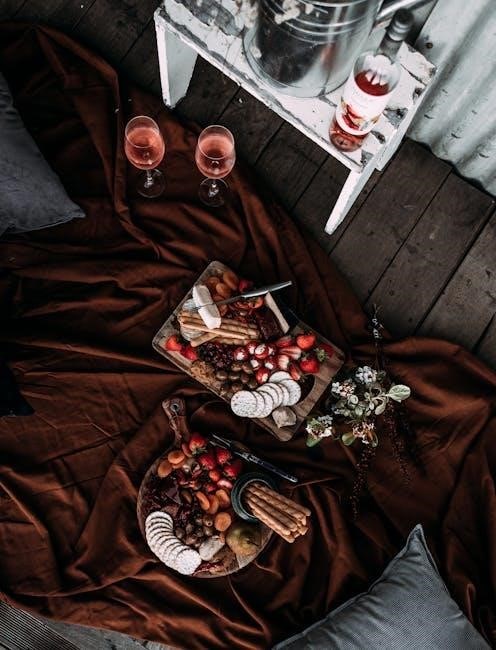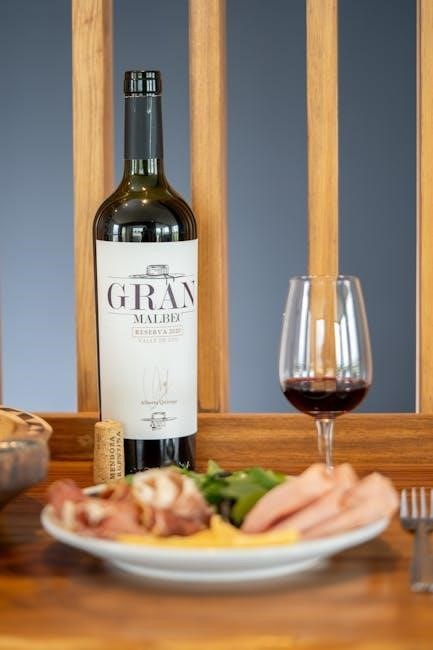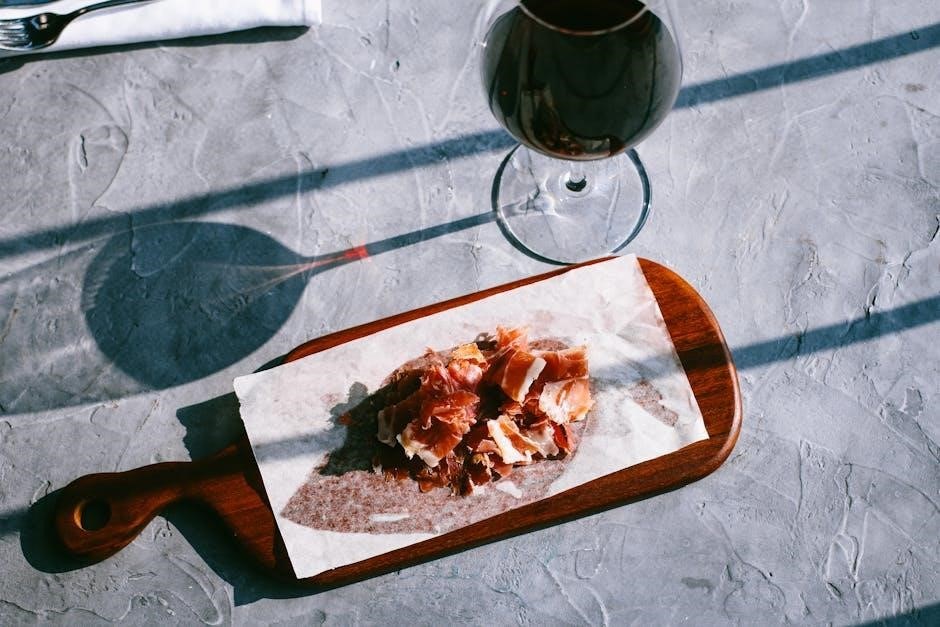A wine and food pairing chart PDF serves as a concise guide to matching dishes with complementary wines‚ ensuring a balanced and harmonious dining experience. It simplifies the complex art of pairing by categorizing wines and foods‚ helping enthusiasts make informed choices. Whether for casual meals or special occasions‚ these charts offer a quick reference to enhance flavor profiles and personal preferences‚ making wine pairing more accessible and enjoyable for everyone.
1.1 The Importance of Wine and Food Pairing
Wine and food pairing enhances the dining experience by balancing flavors‚ textures‚ and aromas‚ creating a harmonious relationship between dishes and wines. A well-paired combination elevates both components‚ showcasing their unique qualities. Understanding this art allows individuals to explore culinary creativity‚ appreciate cultural traditions‚ and personalize meals according to taste preferences. It also highlights the interconnectedness of food and wine‚ making every meal more enjoyable and meaningful.
1.2 Understanding Wine and Food Pairing Charts
Wine and food pairing charts are essential tools for navigating the complexities of matching wines with dishes. These charts categorize wines by type and suggest compatible foods‚ considering factors like flavor profiles‚ textures‚ and preparation methods. They serve as quick references for selecting wines that complement meals‚ offering a structured approach to pairing. Whether for novices or experts‚ these charts simplify the process‚ ensuring a harmonious dining experience by highlighting ideal combinations.

How to Read a Wine and Food Pairing Chart
A wine and food pairing chart organizes wines and dishes into categories‚ guiding users to match flavors and textures effectively. It simplifies pairing decisions for any meal.
2.1 Structure of a Wine and Food Pairing Chart
A wine and food pairing chart is typically organized as a grid or matrix‚ categorizing wines by type (red‚ white‚ sparkling) and foods by protein‚ vegetable‚ or dessert. Rows often list wine varieties‚ while columns detail dish categories. Each cell provides pairing suggestions‚ considering factors like flavor profiles‚ textures‚ and preparation methods. Some charts include symbols or ratings to indicate compatibility levels‚ making it easier to plan meals. Visual simplicity ensures quick‚ effective decision-making for pairing success.
2.2 Key Components of a Pairing Chart
A wine and food pairing chart typically includes categorized lists of wine types (red‚ white‚ sparkling‚ dessert) and food categories (proteins‚ vegetables‚ desserts). It highlights flavor profiles‚ acidity‚ sweetness‚ and tannins to guide pairing decisions. Some charts use symbols or ratings to indicate compatibility‚ while others provide specific pairing suggestions. The goal is to balance flavors‚ textures‚ and preparation methods‚ ensuring a harmonious dining experience tailored to personal preferences and meal contexts.
2.3 How to Use a Pairing Chart for Meal Planning
To effectively use a wine and food pairing chart for meal planning‚ start by identifying the main components of your meal‚ such as proteins‚ vegetables‚ and desserts. Consult the chart to find wines that complement these dishes based on flavor profiles‚ acidity‚ and sweetness. Consider personal preferences and balance flavors by selecting wines that enhance the meal’s overall harmony. This approach ensures a seamless and enjoyable dining experience tailored to your taste and menu.

Basics of Wine and Food Pairing
Understanding the fundamentals of wine types (red‚ white‚ sparkling‚ dessert) and food categories (protein‚ vegetables‚ sauces) is essential. Basic principles like complement or contrast guide pairing‚ ensuring balance and harmony in meals.
3.1 Understanding Wine Types (Red‚ White‚ Sparkling‚ Dessert)
Wine types vary significantly‚ each with unique characteristics. Red wines‚ like Cabernet Sauvignon and Merlot‚ are bold and tannic‚ pairing well with hearty dishes. White wines‚ such as Chardonnay and Sauvignon Blanc‚ are lighter‚ complementing seafood and salads. Sparkling wines‚ like Champagne‚ add festivity to celebrations and pair beautifully with delicate flavors. Dessert wines‚ such as Port and Moscato‚ are sweet and rich‚ perfect for ending meals with a indulgent touch. Understanding these categories is key to effective pairing.
3.2 Understanding Food Categories (Protein‚ Vegetables‚ Sauces)
Proteins‚ such as red meat‚ poultry‚ or seafood‚ are central to many meals. Vegetables‚ whether roasted‚ steamed‚ or sautéed‚ add complexity. Sauces‚ like creamy‚ tangy‚ or spicy‚ significantly influence flavor profiles. Matching these categories with wines ensures harmony. For example‚ bold red wines complement hearty proteins‚ while crisp whites pair with delicate vegetables or seafood. Sauces guide the pairing‚ as creamy textures align with rich whites‚ and spicy notes with refreshing wines. This categorization simplifies the pairing process.
3.3 Basic Pairing Principles (Complement vs. Contrast)
Wine and food pairing revolves around two core principles: complement and contrast. Complementing involves mirroring flavors‚ such as pairing a buttery Chardonnay with creamy sauces. Contrasting emphasizes opposites‚ like matching a crisp Sauvignon Blanc with rich‚ fatty dishes. Both approaches enhance the dining experience by balancing flavors. Understanding these principles helps in selecting wines that either echo or counteract the dish‚ creating a harmonious or exciting flavor profile. This flexibility allows for personalization and creativity in pairing.
Red Wine Pairing Recommendations
Red wines like Cabernet Sauvignon‚ Merlot‚ and Syrah/Shiraz pair well with bold dishes‚ such as red meats‚ game‚ and robust cheeses‚ complementing their rich‚ tannic profiles with hearty flavors.
4.1 Cabernet Sauvignon Pairings
Cabernet Sauvignon‚ a full-bodied red wine‚ pairs exceptionally with grilled red meats like steak‚ lamb‚ and game. Its tannins complement fatty dishes‚ such as roasted duck or braised short ribs. Bold cheeses‚ like aged cheddar or blue cheese‚ also align well with its robust profile. The wine’s dark fruit flavors and spice notes make it ideal for pairing with rich sauces‚ mushrooms‚ and savory spices‚ enhancing the overall dining experience with its balanced acidity and structure.
4.2 Merlot Pairings
Merlot‚ known for its smooth‚ approachable style‚ pairs well with a variety of dishes. It complements pasta with tomato-based sauces‚ grilled or roasted chicken‚ and mild cheeses like mozzarella or goat cheese. Merlot’s plum and blackberry notes also make it a great match for vegetarian dishes‚ such as eggplant parmesan or stuffed bell peppers. Its moderate tannins and balanced acidity allow it to pair seamlessly with earthy flavors‚ ensuring a harmonious and enjoyable dining experience.
4;3 Pinot Noir Pairings
Pinot Noir‚ a light-bodied red wine‚ is renowned for its delicate flavors of cherry‚ raspberry‚ and earthy notes. It pairs exceptionally well with poultry‚ such as roasted chicken or duck‚ and complements delicate fish like salmon. Earthy dishes‚ including mushrooms and vegetarian options like vegetable tart‚ also align beautifully with its subtle acidity and light tannins‚ making Pinot Noir a versatile choice for a variety of cuisines and occasions.
4.4 Syrah/Shiraz Pairings
Syrah/Shiraz‚ a full-bodied red wine‚ is known for its robust tannins and flavors of dark fruit‚ spice‚ and pepper. It pairs exceptionally well with grilled red meats like steak and lamb‚ as well as game meats such as venison. Hearty dishes like braised short ribs and rich stews also complement its bold profile. For vegetarian options‚ earthy mushrooms and robust cheeses like cheddar or gouda are excellent matches‚ balancing the wine’s intensity with their deep‚ savory flavors.

White Wine Pairing Recommendations
White wines offer versatility in pairing‚ with Chardonnay complementing creamy dishes‚ Sauvignon Blanc pairing well with seafood‚ and Riesling excelling with spicy flavors.
5.1 Chardonnay Pairings
Chardonnay‚ with its rich‚ buttery flavors‚ pairs beautifully with creamy dishes‚ roasted chicken‚ and fish like halibut or salmon. Lighter Chardonnays complement delicate seafood‚ while aged varieties match well with nutty cheeses or caramelized vegetables. This versatile white wine enhances a wide range of cuisines‚ from French to modern fusion‚ making it a popular choice for both casual and elegant meals.

5.2 Sauvignon Blanc Pairings
Sauvignon Blanc‚ known for its crisp acidity and citrus notes‚ pairs perfectly with fresh‚ herbaceous‚ and light dishes. It complements seafood like shrimp or scallops‚ goat cheese salads‚ and asparagus. Its zesty profile also matches well with Asian-inspired cuisine‚ such as sushi or stir-fries. For richer options‚ it cuts through fatty or spicy foods‚ making it a versatile choice for various flavors and textures in modern and traditional menus alike.
5;3 Riesling Pairings
Riesling‚ with its range from sweet to dry‚ pairs exceptionally well with a variety of dishes. Its crisp acidity cuts through rich flavors‚ making it ideal for spicy cuisines like Thai or Indian food. Sweet Riesling complements desserts and fruity dishes‚ while dry Riesling pairs nicely with seafood‚ salads‚ and lighter fare. Its versatility makes it a go-to choice for balancing bold flavors and enhancing meal experiences‚ from appetizers to desserts‚ ensuring a harmonious combination every time.
5.4 Pinot Grigio Pairings
Pinot Grigio‚ with its crisp acidity and citrus notes‚ pairs beautifully with lighter dishes. It complements seafood like shrimp‚ scallops‚ and delicate fish‚ as well as herb-roasted chicken. The wine’s bright flavors also enhance fresh vegetable salads‚ pasta with light sauces‚ and vegetarian dishes. Its versatility makes it a perfect choice for meals requiring a refreshing‚ balanced pairing that won’t overpower the flavors of the food‚ ensuring a delightful and harmonious dining experience every time.
Sparkling Wine Pairing Recommendations
Sparkling wines‚ such as Champagne and Prosecco‚ pair elegantly with seafood‚ desserts‚ and rich dishes. Their acidity and effervescence complement a variety of flavors‚ enhancing any meal experience.
6.1 Champagne Pairings
Champagne is incredibly versatile‚ pairing well with delicate seafood like oysters and lobster‚ as well as richer dishes such as roasted poultry or creamy desserts. Its effervescence cuts through fatty or sweet elements‚ making it ideal for balancing flavors. Lighter Champagnes complement subtle flavors‚ while vintage varieties stand up to bold dishes. This bubbly wine is perfect for special occasions‚ offering a sophisticated touch to any meal‚ from appetizers to desserts.
6.2 Prosecco Pairings
Prosecco‚ with its crisp acidity and fruity notes‚ pairs beautifully with lighter dishes like seafood‚ antipasto‚ and brunch items. Its delicate bubbles complement delicate flavors‚ making it ideal for shrimp‚ scallops‚ or eggs Benedict. For desserts‚ it pairs well with fruit-based treats or mildly sweet pastries like tiramisu. Prosecco’s versatility also extends to lighter meats‚ such as herb-roasted chicken or citrus-glazed pork‚ enhancing the dining experience with its refreshing profile and effervescence.
6.3 Sparkling Wine with Seafood
Sparkling wine‚ such as Champagne or Prosecco‚ pairs elegantly with seafood due to its crisp acidity and effervescence‚ which cut through richness. Delicate fish like sole or halibut are complemented by brut Champagne‚ while oysters shine with a dry rosé. Seafood like shrimp‚ scallops‚ or lobster are enhanced by the bubbles and citrus notes in sparkling wines. Even caviar and smoked fish find a luxurious match in premium sparkling varieties‚ creating a refined and balanced flavor experience.
6.4 Sparkling Wine with Desserts
Sparkling wines add a celebratory touch to dessert pairings‚ with their effervescence cutting through sweetness. Moscato pairs beautifully with fruity desserts like raspberry tarts or peach cobbler‚ while Brut Champagne complements rich chocolate cakes or caramelized apple crisps. For creamy treats‚ like crème brûlée or cheesecake‚ a dry sparkling wine balances the sweetness. Sparkling wine with dessert offers a refreshing and sophisticated finish to any meal‚ enhancing the indulgence of sweet dishes.
Dessert Wine Pairing Recommendations
Dessert wines like Moscato‚ Port‚ and Sauternes are perfect for sweet treats. Moscato pairs with fruity desserts‚ while Port complements chocolate and Sauternes matches creamy pastries‚ enhancing sweetness and complexity.
7.1 Port Wine Pairings
Port wine is a rich‚ sweet dessert wine that pairs exceptionally well with chocolate‚ dried fruits‚ and nuts. Tawny Port complements caramel and nutty flavors‚ while Ruby Port matches bold‚ fruity desserts. Vintage Port is ideal for robust cheeses and dark chocolate. When using a wine and food pairing chart PDF‚ Port is often highlighted as a versatile choice for sweet treats‚ offering a luxurious finish to any meal. Personal taste plays a key role in these pairings.
7.2 Moscato Pairings
Moscato is a sweet‚ sparkling wine that pairs delightfully with sweet dishes like fruit tarts‚ creamy desserts‚ and chocolate. Its floral notes make it ideal for lighter fare such as fruit salads or spicy foods. In a wine and food pairing chart PDF‚ Moscato is often recommended for desserts with berries or citrus‚ as well as cheeses like mascarpone. Its refreshing acidity cuts through richness‚ making it a versatile choice for both sweet and savory dishes‚ enhancing the dining experience with its lively charm;
7.3 Sauternes Pairings
Sauternes‚ a luxurious dessert wine‚ is renowned for its sweetness and complexity. It pairs perfectly with rich desserts such as crème brûlée‚ cheesecake‚ and chocolate mousse. Its luscious texture complements cheeses like Roquefort and foie gras. In a wine and food pairing chart PDF‚ Sauternes is often highlighted for its ability to balance sweet and savory flavors‚ making it a versatile choice for enhancing dessert courses with its elegant charm and refined character.
7.4 Tawny Port Pairings
Tawny Port is a versatile dessert wine with nutty‚ caramel flavors. It pairs beautifully with aged cheeses like cheddar or Parmesan‚ dried fruits‚ and nuts. Its smooth profile also complements chocolate-based desserts and caramel sauces. In a wine and food pairing chart PDF‚ Tawny Port is often recommended for its ability to enhance the richness of sweet and savory dishes‚ making it a delightful choice for both traditional and modern dessert pairings.

Special Considerations in Wine and Food Pairing
Consider personal taste‚ cultural traditions‚ and meal context when pairing. A wine and food pairing chart PDF can guide choices‚ ensuring harmony between flavors and preferences.
8.1 Pairing Wine with Cheese
Pairing wine with cheese requires balancing flavors and textures. Soft cheeses like Brie or Camembert pair well with white wines such as Chardonnay or Riesling‚ while aged cheeses like Cheddar complement red wines like Cabernet Sauvignon. A wine and food pairing chart PDF can guide selections‚ offering tailored recommendations for various cheese types and wine styles‚ ensuring a harmonious match.
8.2 Pairing Wine with Spicy Food
Pairing wine with spicy food can be challenging‚ as heat alters flavor perceptions. Sweet wines like Riesling or Moscato often complement spicy dishes by balancing heat with sweetness. Sparkling wines‚ such as Prosecco‚ can cleanse the palate between bites. For bold‚ fiery cuisines‚ low-tannin reds like Pinot Noir are suitable. A wine and food pairing chart PDF provides tailored recommendations‚ helping enthusiasts navigate spicy food and wine combinations effortlessly for enhanced dining experiences.
8.3 Pairing Wine with Vegetarian Dishes
Vegetarian dishes offer diverse pairing opportunities‚ from crisp whites for salads to earthy reds for hearty options. Sauvignon Blanc complements fresh herbs and greens‚ while Pinot Grigio pairs well with lighter vegetable dishes. For richer vegetarian meals‚ such as eggplant or mushroom-based dishes‚ a light-bodied red like Pinot Noir is ideal. A wine and food pairing chart PDF provides tailored suggestions‚ ensuring wines enhance the natural flavors of plant-based cuisine‚ making meal planning effortless and enjoyable;

Advanced Wine and Food Pairing Techniques
Advanced techniques involve balancing texture‚ acidity‚ and tannins to elevate dining experiences. A wine and food pairing chart PDF helps refine these methods‚ ensuring meals are enhanced and preferences are met.
9.1 Considering Wine and Food Texture
Matching wine and food textures enhances the dining experience. A wine and food pairing chart PDF guides this process‚ suggesting smooth wines like Chardonnay for creamy dishes and crisp whites for delicate textures. Red wines with firm tannins pair well with hearty meats. By aligning textures‚ both elements complement each other‚ creating a harmonious balance that elevates the meal; This technique ensures each bite and sip are perfectly synchronized and enjoyable.
9.2 Balancing Wine Acidity with Food
A wine and food pairing chart PDF emphasizes the importance of acidity in balancing flavors. High-acidity wines‚ like Sauvignon Blanc‚ cut through rich or fatty dishes‚ while lower-acidity wines complement delicate flavors. Acidity enhances brightness and refreshment‚ making it a key factor in harmonizing wine and food. This balance ensures a vibrant and well-rounded dining experience‚ as outlined in detailed pairing guides. Proper acidity alignment elevates both the dish and the wine‚ creating a seamless match.
9.3 The Role of Tannins in Pairing
Tannins in wine play a crucial role in food pairing by balancing richness and enhancing structure. High-tannin wines‚ such as Cabernet Sauvignon‚ complement fatty meats and robust dishes‚ while lower-tannin wines like Pinot Noir suit lighter fare. A wine and food pairing chart PDF highlights how tannins interact with food textures‚ ensuring harmony and depth. This balance prevents overpowering flavors‚ making tannins a key element in creating a refined and enjoyable culinary experience.
Psychological and Cultural Factors in Pairing
Cultural traditions and personal preferences heavily influence wine and food pairing choices‚ shaping perceptions of harmony and balance. Regional customs often dictate pairing norms‚ making it a deeply subjective experience.
10.1 Personal Taste and Preferences
Personal taste plays a significant role in wine and food pairing‚ as preferences for sweetness‚ acidity‚ or bitterness vary greatly. Individual palates influence how flavors are perceived‚ making pairing subjective. The adaptability of taste buds to salt‚ sugar‚ and acid levels affects perceptions of wine and food. Tools like pairing charts and guides help individuals explore pairings aligned with their unique preferences‚ enhancing the dining experience based on personal flavor profiles and cultural background influences.
10.2 Cultural Influences on Pairing Traditions

Cultural traditions deeply influence wine and food pairing practices‚ with regional cuisine often dictating local wine preferences. For example‚ Middle Eastern wines pair well with spicy dishes‚ while Japanese cuisine favors light wines like Pinot Grigio for sushi. European traditions‚ such as pairing red Bordeaux with rich meats‚ highlight cultural preferences. These practices‚ reflected in pairing charts‚ showcase how regional flavors and culinary habits shape wine pairing norms‚ preserving cultural heritage and enhancing dining experiences worldwide.
10.3 The Impact of Meal Context on Pairing
The context of a meal significantly influences wine pairing decisions. Formal dinners may call for bold‚ full-bodied wines‚ while casual gatherings might favor lighter‚ crisp options. Cultural traditions‚ personal preferences‚ and the number of courses also play a role. A wine and food pairing chart PDF can help navigate these contextual influences‚ ensuring wines complement the occasion‚ enhancing the overall dining experience and creating memorable moments for hosts and guests alike.

Resources for Wine and Food Pairing
Explore comprehensive guides like Wine Folly’s wine and food pairing chart PDF‚ offering detailed matchups for red‚ white‚ and sparkling wines with various dishes‚ sauces‚ and desserts.
11.1 Recommended Wine and Food Pairing Charts
Top-rated resources include Wine Folly’s Wine and Food Pairing Chart PDF and Happy Harry’s Wine and Food Pairing Chart. These charts provide detailed matchups for red‚ white‚ and sparkling wines with dishes‚ sauces‚ and desserts. They also cover pairing principles‚ ensuring a balanced and harmonious dining experience. Download these guides to explore comprehensive pairing suggestions‚ perfect for planning meals or enhancing your knowledge of wine and food interactions.
11.2 Books on Wine and Food Pairing

Explore authoritative books like “The Wine Bible” by Karen MacNeil and “Wine Folly: The Essential Guide to Wine” by Madeline Puckette. These resources offer comprehensive pairing techniques‚ detailed charts‚ and expert advice. “The Food & Wine Pairing Chart” by Wine Folly provides visual guides‚ while “Pairing Wine with Asian Food” by Jeannie Cho Lee specializes in regional cuisines. These books are indispensable for mastering the art of pairing.
11.3 Online Guides and Tools
Discover wine and food pairing chart PDFs and interactive tools online. Resources like Wine Folly offer detailed charts and guides‚ while Happy Harry’s Wine and Food Pairing Chart provides downloadable PDFs. Websites such as Chef to Chef and Honest Wine Reviews also share comprehensive pairing suggestions. Additionally‚ apps and online platforms allow users to input ingredients or wine types for tailored recommendations‚ making pairing easier and more accessible for enthusiasts of all levels.

